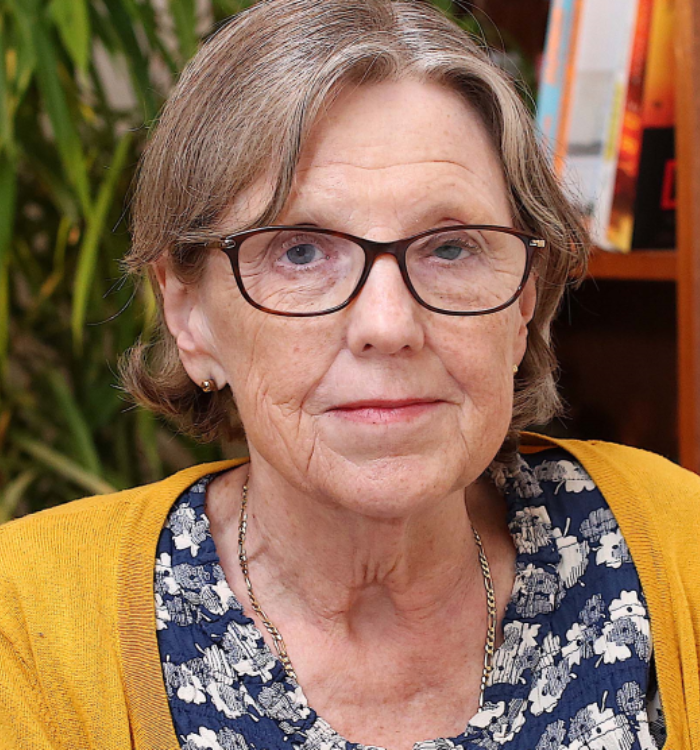Georgina Mace Prize
The Georgina Mace Prize is awarded annually to the best article by an early career researcher in Ecological Solutions and Evidence.
About Professor Dame Georgina Mace

As a conservation scientist, Georgina’s work on the measurement and consequences of biodiversity loss had far-reaching and long-lasting impacts.
Early in her career, Georgina worked with the IUCN to develop scientifically robust criteria for the inclusion of species on their Red List of Threatened Species. She was one of the first scientists to demonstrate that the extinction risk of a species can be predicted based on a few key characteristics even when the species’ actual status in the wild is unknown, and this allowed species that were being dangerously overexploited to be identified. Georgina’s influence on policy included her role as a founding member of the Natural Capital Committee, where she developed a framework to bring the environment into economic decision-making.
Georgina was also extremely generous with her time and experience in support of early career ecologists. The Editors of Ecological Solutions and Evidence are delighted to name the annual prize for the best research paper by an early career author in honour of the first female President of the British Ecological Society.
Georgina’s personal contributions to science are well documented. What took her family by surprise was the number of people she “helped along the way” early on in their careers. She didn’t talk about that so much, it was just what she did, all in a day’s work. So it’s entirely fitting and an honour that she should be remembered in this way, giving her name to a prize for best early career researcher.
– Rod Evans, Georgina Mace’s husband
The Prize
The winner of the Georgina Mace Prize is selected by the Editors of Ecological Solutions and Evidence at the end of each year and an announcement is made early in the following year. The Prize is awarded to the best article published in the journal by an ecological researcher at the start of their career.
In the absence of extenuating circumstances, ‘Early Career’ is defined as less than 5 years post- Ph.D. or -D.Phil. according to the date of the author’s graduation certificate, or less than 5 years’ work experience in environmental management according to the start date of first employment role. The winner of the Mendes Prize will receive £500, membership of the British Ecological Society, and have the registration fees covered to attend the BES Annual Meeting if they wish to give a presentation on their work.
Ecological Solutions and Evidence also awards the Chico Mendes Prize for the best Practice Insights article by an early career author, which is announced biennially.
Past winners: 2022 | 2021 | 2020
Winner of the 2023 prize

Melanie Dickie
Melanie Dickie, Branislav Hricko, Christopher Hopkinson, Victor Tran, Monica Kohler, Sydney Toni, Robert Serrouya & Jahan Kariyeva (Ecological Solutions and Evidence. 2023; 4:e12254)
For many species at risk, population declines can be traced back to habitat and therefore, at the most basic level, management requires an understanding of current habitat status and it changes over time. But often habitat inventories at appropriate scales are logistically difficult and cost-prohibitive, and anthropogenic habitat alterations are continuously on the rise.
In this study, Melanie Dickie and colleagues capitalise on the exciting developments in remote-sensing tools for ecological research by applying multiple remote sensing tools to collect data on vegetative habitat associated with threatened woodland caribou (Rangifer tarandus caribou) in the boreal forests of Canada. They use semi-automated and manual methodologies to fuse photogrammetry point clouds (PPC) from high resolution aerial imagery with wide-area light detection and ranging (LiDAR) data to quantify vegetation structure and validate their remotely collected data with multiple, more traditional measures to demonstrate their accuracy.
The Editors were impressed by the wide-ranging application of the study for monitoring vegetation patterns across multiple scenarios, temporal, and spatial scales, including tracking changes related to climate change, wildfires, post-disturbance recovery and habitat restoration. Lead Editor Professor Carolyn Kurle highlighted how the article is a terrific contribution to the ongoing effort to understand and decelerate habitat and species biodiversity loss around the world.
About the author: Melanie has been interested in the natural world for as long as she can remember, spending her childhood outdoors never wavering from these early interests. She leaned into the world of ecology and predator-prey interactions from her undergraduate studies before developing an appreciation of the role of habitats underneath those interactions through her masters and doctoral studies. Melanie now works on understanding how habitat changes influence predator-prey interactions and what tools scientists can use to measure each of the links in the chain, tying those small details to the bigger picture.
Winner of the 2022 prize

Luke Potgieter
Prioritizing sites for terrestrial invasive alien plant management in urban ecosystems
Luke J. Potgieter, Namrata Shrestha, Marc W. Cadotte (Ecological Solutions and Evidence. 2022; 3:e12160)
Rapid urbanization is placing increased pressure on natural, restored and designed ecosystems to provide services to growing human populations. The establishment and spread of invasive alien species within and around urban areas threaten biodiversity and ecosystem functioning, and the services they provide. There is therefore an urgent need to protect and manage areas where biological invasions will have the greatest socio-ecological impact.
In this study, Luke Potgieter and colleagues apply multi-criteria decision analyses and spatial modelling techniques to develop a strategic, spatial prioritization approach for identifying sites most vulnerable to new or expanding terrestrial alien invasions in urban landscapes. They consulted with local conservation authorities to develop multiple criteria to inform their prioritization scheme; the criteria spanned biodiversity and ecosystem services measurements. Potgieter et al. then compared the areas their analysis showed were sensitive to invasion with the range of a particularly invasive plant species in the area to show that many of the areas sensitive to invasion were indeed already invaded. Ultimately, the research yielded spatially explicit recommendations on where managers should focus their plant invasion control and prevention efforts.
This exciting study combines aspects of social science, geography and ecology to produce research that can help managers make more informed decisions. The Editors highlighted the critical importance of such studies that help managers understand where resources can be focused to gain the most benefit per effort spent in a world where resource is increasingly scarce. Lead Editor Holly Jones was especially impressed by how the approach can be more broadly applied by others looking to prioritize management in areas beyond their study region and at other spatial scales.
Luke became interested in invasive species at an early age when the extraordinary diversity surrounding the farm he lived on just outside of Cape Town, South Africa, became increasingly transformed for agriculture and invasive species established themselves as regular features of the landscape. His winning article was part of a broader project with the local conservation authority in Toronto, Canada, which he worked on during the COVID-19 pandemic, and he has since drawn from the approaches used in his study for several subsequent projects in cities across South Africa.
Read Luke’s blog post about the research here.
Winner of the 2021 prize

Sara Bronwen Hunter
Sara B. Hunter, Sophus O. S. E zu Ermgassen, Harriet Downey, Richard A. Griffiths, Caroline Howe (Ecological Solutions and Evidence. 2021; 2:e12089)
Infrastructure expansion is one of the most significant pressures on biodiversity worldwide and currently threatens around a third of species on the IUCN Red List. The combined pressures of continued biodiversity loss and commitments to infrastructure expansion under the Sustainable Development Goals present an urgent need to mitigate the environmental impact of development. In the UK, ecological mitigation and compensation (EMC) measures are widely implemented during development following the policies that protect species from these impacts, but evidence shortfalls remain a barrier to making informed recommendations of such measures.
In this study, Sara Bronwen Hunter and colleagues evaluate the effectiveness of the EMC measures used in practice by identifying the guidance that inform them and closely examining the empirical evidence. By assessing the identified measures against synopses on Conservation Evidence – a database summarising scientific evidence for the effects on conservation actions – the team revealed significant gaps in the evidence to support commonly recommended measures, as well as a lack of up-to-date, evidence-based guidance. The research provides key justification for future studies exploring the outcomes of EMC measures and emphasises the need for improved evidence-use to effectively protect the species and habitats affected by development.
With very few comprehensive reviews on EMC measures, the journal’s Editors unanimously pointed out the importance of Bronwen’s research due to its direct relevance to species conservation and management amidst ever-increasing urbanisation. The lack of empirically tested mitigation measures is a serious concern if we hope to effectively offset the ecological impacts from development and infrastructure, and Lead Editor Holly Jones highlights how exposing these knowledge gaps provide further evidence for policy makers to strengthen EMC measures and ensure they’re rooted in scientific evidence.
Bronwen grew her interests in ecology during her undergraduate degree in Biology and decided to pursue a career in research during her master’s degree at the Centre for Environmental Policy, Imperial College London. The winning research is drawn from her MSc thesis which was conducted during the COVID-19 lockdown and soon after finishing, she started a PhD at University of Sussex where she is currently studying in her second year.
Read Bronwen’s blog post about the research here.
Winner of the 2020 prize

Christina Service
Christina N. Service, Mathieu Bourbonnais, Megan S. Adams, Lauren Henson, Douglas Neasloss, Chris Picard, Paul C. Paquet, Chris T. Darimont (Ecol Solut Evidence. 2020; 1:e12014)
While the American black bear (Ursus americanus) is a species of least concern, a phenotypic variant of the subspecies, Ursus americanus kermodei, is not only the thing of legend, but has a very restricted geographical distribution. The ‘spirit bear’ is a completely white bear, which is not albino, and is cultural important to indigenous populations that inhabit coastal British Columbia , Canada. With only about 400 spirit bears believed to exist and questions about how this white colour is maintained genetically, it is crucially important to understand their population and degree of protection from resource extraction and trophy hunting.
In this study, Christina Service and colleagues use data from Indigenous-led research in the territories of the Kitasoo/Xai’xais and Gitga’at First Nations to identify that the allele responsible for spirit bears is up to 50% rarer than previously estimated. Further, they indicate that geographic hotspots, where the spirit bear allele was especially prominent, lack adequate protection from resource extraction such as industrial logging. The research provides new insight into our understanding of this rare polymorph and provides an opportunity for further collaboration with Indigenous Nations in the area to grow the evidence-base and attend to gaps in conservation planning.
The journal’s Editors were impressed with the authors’ incorporation of, and collaboration with, indigenous knowledge and people to further their understanding of a culturally important species. Editor-in-Chief, Marc Cadotte, also highlighted the authors’ fantastic use of multiple techniques, describing the study as a superb example of combining observational, genetic and spatial information to provide unparalleled information for species conservation.
Christina grew up in coastal British Columbia, where the research was conducted, and pursued a career in applied ecology to help inform stewardship of the landscapes she cared about, as well as having the opportunity to spend time in these places. The prize-winning research was part of her PhD – which she successfully defended in 2019 – and her research team is continuing to build upon this work to produce population estimates for spirit bears within the broader black bear population. This information, combined with the research in ESE, will be used for long-term monitoring of spirit bear populations in coastal British Columbia.
Read Christina’s blog post about the research here.
Like what we stand for?
Support our mission and help develop the next generation of ecologists by donating to the British Ecological Society.